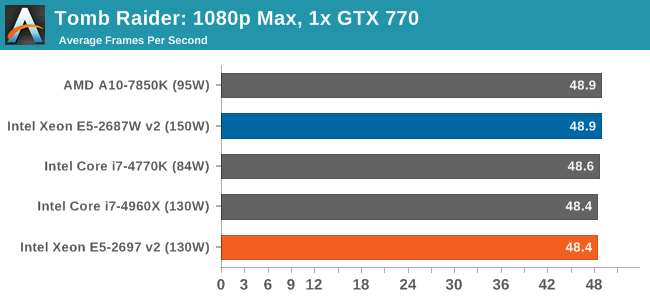Intel Xeon E5-2697 v2 and Xeon E5-2687W v2 Review: 12 and 8 Cores
by Ian Cutress on March 17, 2014 11:59 AM EST- Posted in
- CPUs
- Intel
- Xeon
- Enterprise
For our gaming benchmarks we brought in the MSI X79A-GD45 for some three-way GPU action, as the original GIGABYTE motherboard is limited beyond two GPUs. For the Xeons in our tests, the PCIe arrangement gave x16 in single GPU mode, x16/x16 in dual GPU mode and x16/x16/x8 in tri-GPU mode.
F1 2013
First up is F1 2013 by Codemasters. I am a big Formula 1 fan in my spare time, and nothing makes me happier than carving up the field in a Caterham, waving to the Red Bulls as I drive by (because I play on easy and take shortcuts). F1 2013 uses the EGO Engine, and like other Codemasters games ends up being very playable on old hardware quite easily. In order to beef up the benchmark a bit, we devised the following scenario for the benchmark mode: one lap of Spa-Francorchamps in the heavy wet, the benchmark follows Jenson Button in the McLaren who starts on the grid in 22nd place, with the field made up of 11 Williams cars, 5 Marussia and 5 Caterham in that order. This puts emphasis on the CPU to handle the AI in the wet, and allows for a good amount of overtaking during the automated benchmark. We test at 1920x1080 on Ultra graphical settings for a single GPU, as using multiple GPUs seems to have no scaling effect.

| F1 2013, 1080p Max | ||
| NVIDIA | AMD | |
| Average Frame Rates |
|
|
| Minimum Frame Rates |
|
|
While the higher frequency of the E5-2687W v2 puts it ahead of the 12-core Xeon, in each of our data points, except 3x HD7970, the Core i7-4960X gets the better frame rates.
Bioshock Infinite
Bioshock Infinite was Zero Punctuation’s Game of the Year for 2013, uses the Unreal Engine 3, and is designed to scale with both cores and graphical prowess. We test the benchmark using the Adrenaline benchmark tool and the Xtreme (1920x1080, Maximum) performance setting, noting down the average frame rates and the minimum frame rates.

| Bioshock Infinite, 1080p Max | ||
| NVIDIA | AMD | |
| Average Frame Rates |
|
|
| Minimum Frame Rates |
|
|
Again, the 8-core higher frequency Xeon is faster than the 12-core Xeon in most of our tests, however the i7-4960X beats them most of the time. For certain arrangements, such as 2x HD7970, the Xeons lose slightly to the i7-4770K, most likely due to CPU IPC. However as the difference is only a couple of frames per second out of 130, this should not make much difference.
Tomb Raider
The next benchmark in our test is Tomb Raider. Tomb Raider is an AMD optimized game, lauded for its use of TressFX creating dynamic hair to increase the immersion in game. Tomb Raider uses a modified version of the Crystal Engine, and enjoys raw horsepower. We test the benchmark using the Adrenaline benchmark tool and the Xtreme (1920x1080, Maximum) performance setting, noting down the average frame rates and the minimum frame rates.

| Tomb Raider, 1080p Max | ||
| NVIDIA | AMD | |
| Average Frame Rates |
|
|
| Minimum Frame Rates |
|
|
In all the Tomb Raider tests, all the CPUs perform similarly, making Tomb Raider a seemingly agnostic test to CPU power.













71 Comments
View All Comments
mrnuxi - Tuesday, March 18, 2014 - link
I know you were benchmarking these Xeons for home use, thus the selection of rendering and gaming benchmarks. But there are lots of us doing home virtualization (VMWare ESXi all-in-one servers using PCI-passthrough ZFS virtual SAN and multiple VMs). It would be great so see some virtualization benchmarks. For further reference see: http://www.napp-it.org/index_en.htmlIan Cutress - Tuesday, March 18, 2014 - link
Johan covered the server side in his article -http://www.anandtech.com/show/7285/intel-xeon-e5-2...
alpha754293 - Wednesday, March 19, 2014 - link
No LS-DYNA or other HPC benchmark results??? Talk to Johan.colonelclaw - Wednesday, March 19, 2014 - link
Hi Ian, Thanks for a great review.Do you think there's any possibility of adding V-Ray to your workstation benchmarks? It's an incredibly popular renderer that is multi-platform and also works in pretty much any decent 3D software (Max, Maya, C4D etc). It also sucks the life out of any computer when it's running, so would be perfect for your tests.
Kougar - Wednesday, March 19, 2014 - link
Question. Since you discuss turbo bins at length and the article revolves around them, how does Windows Server handle load balancing in regards to the turbo bins. On a 2P E5-2697 will the OS balance all the threads on a single CPU first? Spread evenly across both CPUs? Max out all physical cores before assigning threads to logical cores?Is the OS capable of spreading 3 threads to each processor to ensure they both run at the max turbo frequency for as long as possible? Or would it instead max out one processor to attempt to let the other retain a lower power state? For that matter is any of this even configurable under Windows Server?
Ytterbium - Saturday, May 3, 2014 - link
Ian, does MCE work with Xeon?Ytterbium - Tuesday, May 6, 2014 - link
MCE doesn't seem to work with Xeon 2687w.RadamanthysBe - Sunday, May 4, 2014 - link
Interresting article, but I dont agree with your conclusion on the 2667 vs 2687w :You say 2667 id cheaper, ok but 50 $ difference in list price on cpu costing 2100 $, that is less than 2%.
You also say 2687w v2 use more energy than 2667 v2, do you have proof of that ? For me the fact that 2687w v2 has a 150w tdp only mean it can keep its turbo frequency under higher load than 2667, with situations where 2667 turbo mode would drop because of the power usage while not on the 2687w v2, making it in fine a faster cpu than 2667 under heavy loads. If the two cpu run the same computation at the same frequency, there is no reason 2687w v2 uses more power, it would be like saying that i5 and i7 consume the same because they have the same tdp, while everybody knows it is not the case.
Ytterbium - Monday, May 5, 2014 - link
I just bought a 2687w v2, it ended up being $3 difference between them, I have i7-3970X so I have 150W chip anyway, so TDP wasn't really much of a factor to me.It would be interesting to do a head to head of them and see how they perform, in thermal load/power.
Following Ian's logic he's be super interested in the E5-2673 v2, this is the same as the 2667 but with 110W TDP.
If the 2690 had a little higher turbo, it would be great, 10/20 with say 3 stock and 3.8 turbo
Ytterbium - Tuesday, May 6, 2014 - link
The 2687 I got seems to run a bit cooler than my 3970X, even though there rated for the same.